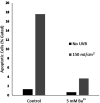Apoptosis of Corneal Epithelial Cells Caused by Ultraviolet B-induced Loss of K(+) is Inhibited by Ba(2.)
- PMID: 27189864
- PMCID: PMC5679194
- DOI: 10.1016/j.jtos.2016.05.001
Apoptosis of Corneal Epithelial Cells Caused by Ultraviolet B-induced Loss of K(+) is Inhibited by Ba(2.)
Abstract
UVB exposure at ambient outdoor levels triggers rapid K(+) loss and apoptosis in human corneal limbal epithelial (HCLE) cells cultured in medium containing 5.5 mM K(+), but considerably less apoptosis occurs when the medium contains the high K(+) concentration that is present in tears (25 mM). Since Ba(2+) blocks several K(+) channels, we tested whether Ba(2+)-sensitive K(+) channels are responsible for some or all of the UVB-activated K(+) loss and subsequent activation of the caspase cascade and apoptosis. Corneal epithelial cells in culture were exposed to UVB at 80 or 150 mJ/cm(2). Patch-clamp recording was used to measure UVB-induced K(+) currents. Caspase-activity and TUNEL assays were performed on HCLE cells exposed to UVB followed by incubation in the presence or absence of Ba(2+). K(+) currents were activated in HCLE cells following UVB-exposure. These currents were reversibly blocked by 5 mM Ba(2+). When HCLE cells were incubated with 5 mM Ba(2+) after exposure to UVB, activation of caspases-9, -8, and -3 and DNA fragmentation were significantly decreased. The data confirm that UVB-induced K(+) current activation and loss of intracellular K(+) leads to activation of the caspase cascade and apoptosis. Extracellular Ba(2+) inhibits UVB-induced apoptosis by preventing loss of intracellular K(+) when K(+) channels are activated. Ba(2+) therefore has effects similar to elevated extracellular K(+) in protecting HCLE cells from UVB-induced apoptosis. This supports our overall hypothesis that elevated K(+) in tears contributes to protection of the corneal epithelium from adverse effects of ambient outdoor UVB.
Keywords: K(+) channel; apoptosis; caspase; corneal epithelium; potassium; tears; ultraviolet.
Copyright © 2016 Elsevier Inc. All rights reserved.
Conflict of interest statement
The authors have no proprietary or commercial interest in any concept or product discussed in this article.
Figures







References
-
- Bortner CD, Hughes FM, Cidlowski JA. A primary role for K+ and Na+ efflux in the activation of apoptosis. J Biol Chem. 1997;272:32436–542. - PubMed
-
- Hughes FM, Bortner CD, Purdy GD, Cidlowski JA. Intracellular K+ suppresses the activation of apoptosis in lymphocytes. J Biol Chem. 1997;272:30567–76. - PubMed
-
- Wang L, Xu D, Dai W, Lu L. An ultraviolet-activated K+ channel mediates apoptosis of myeloblastic leukemia cells. J Biol Chem. 1999;274:3678–85. - PubMed
-
- Wang L, Li T, Lu L. UV-induced corneal epithelial cell death by activation of potassium channels. Invest Ophthalmol Vis Sci. 2003;44:5095–101. - PubMed
-
- Arrebola F, Fernández-Segura E, Campos A, et al. Changes in intracellular electrolyte concentrations during apoptosis induced by UV irradiation of human myeloblastic cells. Am J Physiol Cell Physiol. 2006;290:C638–49. - PubMed
MeSH terms
Substances
Grants and funding
LinkOut - more resources
Full Text Sources
Other Literature Sources

